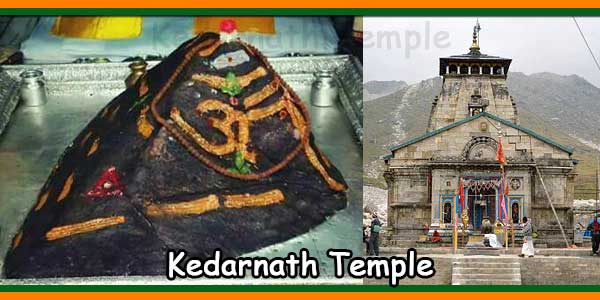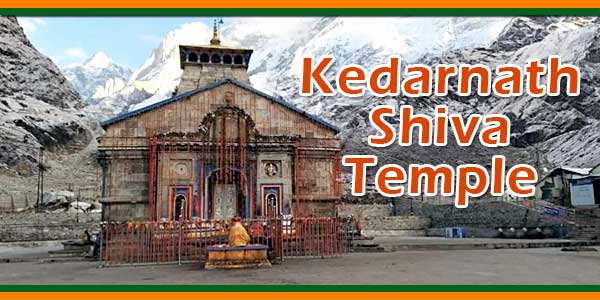The temple is at an altitude of 3,583 m amd 223 km from Rishikesh, on the banks of the River Mandakini, a tributary of the Ganges, is a stone building of unknown date. It is not certain who built the original Kedarnath temple and when. The name “Kedarnath” means “the lord of the field”: it derives from the Sanskrit words kedara and natha. The text Kashi Kedara Mahatmya states that it is called that because “the harvest of liberation” grows here.
During the winters of November, there is heavy snowfall in Kedarnath and all routes are closed with snow. The sanctuary is also closed for 6 months. The holy statue of Lord Shiva, is shifted from Garhwal (Kedarkhand) to Ukhimath, and is reinstated in Kedarnath, the first week of May. It was at this time that the doors of the temple opened to pilgrims, who gathered from all parts of India, for a sacred pilgrimage. The sanctuary closes the week of Kartika, the day of Bhai Dooj (October-November) and reopens each year after Akshay Tritya (April-May). When it is closed, the sanctuary is immersed in snow and worship takes place in Ukhimath.
Kedarnath Dham opens its doors to pilgrims from April to May each year with great celebrations. The opening dates of the temple of Kedarnath announced on the occasion of Mahashivratri. Thousands of pilgrims visit the sanctuary of Kedarnath on the opening day. Watch the Kedarnath opening video here and plan your trip to visit Kedarnath Dham. Kedarnath Temple has a long ceremonial puja at the time of opening of Kedarnath shrine. Main Pujari Rawal of Kedarnath first takes blessing and view of lingam after opening of Kedarnath temple.
Kedarnath Temple Pooja and Rituals:
Mahabhishek
Rudrabhishek – Pooja performed to wipe out all the sins.
Laghurudrabhishek – Abhishek is made to solve problems related to health and wealth or to eliminate the bad effects of planets in the horoscope.
Shodasopachar Pooja
The evening poojas are held between 6:00 PM to 07:30 PM. They are:
Shiva Sahasranamam Paath – 1008 names of Lord Shiva are recited.
Shiva Mahimastotra Paath – stotrams which have 16 syllables per stotra are recited as they describe Lord Shiva’s power and beauty.

Kedarnath Temple History:
According to a theological account, God Shiva agreed to live here at the request of Nara-Narayana. After the Kurukshetra War, the Pandava brothers came here to meet Lord Shiva on the advice of sage Vyasa, because they wanted to apologize for having killed their loved ones during the war. However, Shiva did not want to forgive them: he became a bull and hid among the cattle on the hill. When the Pandavas managed to find him, he tried to disappear by sinking his head into the ground. One of the brothers grabbed him by the tail, forcing him to appear before them and forgive them. The Pandava brothers built the first temple in Kedarnath. Shiva’s body parts then appeared in four other places; and collectively, these five places became known as the five Kedaras, the bull’s head appeared at the site of Rudranath.
The Mahabharata, which explains the Pandavas and the Kurukshetra War, does not mention any place called Kedarnath. One of the earliest references to Kedarnath is found in Skanda Purana, which contains a story that describes the origin of the Ganges. The text names Kedara (Kedarnath) as the place where Shiva released holy water from his tangled hair.
According to hagiographies based on Madhava’s Sankshepa-shankara-vijaya, the eighth century philosopher Adi Shankara died in Kedaranatha; although other hagiographies, based on Anandagiri’s Prachina-Shankara-Vijaya, state that he died in Kanchi. The ruins of a monument that marks Shankara’s supposed place of death are in Kedarnath. Kedarnath was certainly an important pilgrimage center in the 12th century, when it is mentioned in Kritya-kalpataru written by the minister of Gahadavala, Bhatta Lakshmidhara.
According to a tradition recorded by the English mountaineer Eric Shipton (1926), “several hundred years ago”, the temple of Kedarnath did not have a local priest: the priest of the temple of Badrinath held services in both temples, traveling between the two places everyday.
Best Season to Visit Kedarnath Temple:
The Kedarnath Dham remains open to pilgrims for only a few months. This is due to the extreme weather conditions. The climate of Kedarnath remains cold for most of the year. Even during the summers, the weather can be very cold at night.

Summer Season:
It is the best season to visit Kedarnath Temple. Summer in Kedarnath takes place from April to June. The view is magnificent and there is freshness everywhere. Although, even in the summers, it can get very cold at night. You should wear appropriate warm clothing to protect yourself.
Monsoon Season:
July and August are the monsoon months in Kedarnath. This place experiences heavy rain during these months. There are possibilities for landslides and floods. It is recommended not to travel during these months.
Pre-Winter Season:
September and October cover the pre-winters. This time it is also very ideal to visit Kedarnath Dham. Right after the rains, the weather becomes very beautiful. The place is full of greenery. The beauty of the whole region increases during this period.
Winter Season:
Winters in this location start in late November and continue until March. During this time, the place will witness heavy snowfall. Due to the extremely cold weather, the shrines are closed to pilgrims. It reopens in April.
Plaves Near Kedarnath Temple:
Triyuginarayan
Guptakashi
Chopta
Panchkedar
Madmaheshwar
Tungnath
Rudranath
Kalpeshwer
Vasuki Tal
Gandhi Sarovar
Bhairavnath Temple
Kedarnath Temple Festivals:
Badri-Kedar Utsav – celebrated for 8 days.
Shravani Annakoot Mela – Entire Jyotirlinga is covered with cooked rice which is later distributed to devotees as Prasad.
Samadhi Pooja – Pooja performed at Sri Adi Shankaracharya Samadhi.
Kedarnath Temple Visit Tips:
Take enough woolen clothes with you as the temperature drops after sunset.
Alcohol is strictly prohibited.
Take basic medicines with you.
Asthmatics should take extra care as the altitude is high.
Bring mosquito or insect repellent to avoid illnesses such as malaria.
Avoid eating raw and cold foods. Boiled or cooked food is safer.
During the yatra, do not relax in places where warning signs are visible.
To avoid sunburn, continue to apply sunscreens.
Avoid drinking tap water.
You must obtain a medical certificate before embarking on the trek to Kedarnath. These can be obtained in Guptkashi and Sonprayag.
How To Reach Kedarnath Temple:
Unfortunately, vehicles are only allowed at the Kedarnath Temple. All buses or cars are allowed till Gaurikund, after which devotees have to walk about 16 km to reach the temple. The trekking route during the first 7 km is moderate, but it becomes quite steep after Rambara for the next 7 km. The last 3 kilometers are hilly and go up and down gradually. It takes approximately 7 hours to get to Kedarnath from Gaurikund. Medical facilities, tea shops, toilets and police stations at each checkpoint. Ponies and horses are also available on this trek and you can make a reservation before starting the trek with a nominal fee. Gaurikund is well connected by road through major cities such as Haridwar, Dehradun and Rishikesh.
Kedarnath Temple Address:
Shri Badrinath – Shri Kedarnath Temples Committee
Maa Chandra Badni Temple,
Near Kargi Chowk & Oberoi Nissan Motors,
Kargi Grant,
Haridwar By-pass road,
Dehradun,
Uttarakhand – 248001.
Other Jyotirlinga Temples are:
1) Somnath Temple in Gujarat
2) Mahakaleshwar Temple in Madhya Pradesh
3) Omkareshwar Temple in Madhya Pradesh
4) Bhimashankar Temple in Maharashtra
5) Kashi Vishwanath Temple in Uttar Pradesh
6) Trimbakeshwar (or) Tryambakeshwar Shiva Temple in Maharashtra
7) Ramanathaswamy Temple in Tamil Nadu
8) Grishneshwar Temple in Maharashtra
9) Vaidyanath Temple in Jharkhand
10) Nageshwar Temple (or) Aundha Nagnath Temple in Gujarat
11) Srisailam Mallikarjuna Swami Temple in Andhra Pradesh

